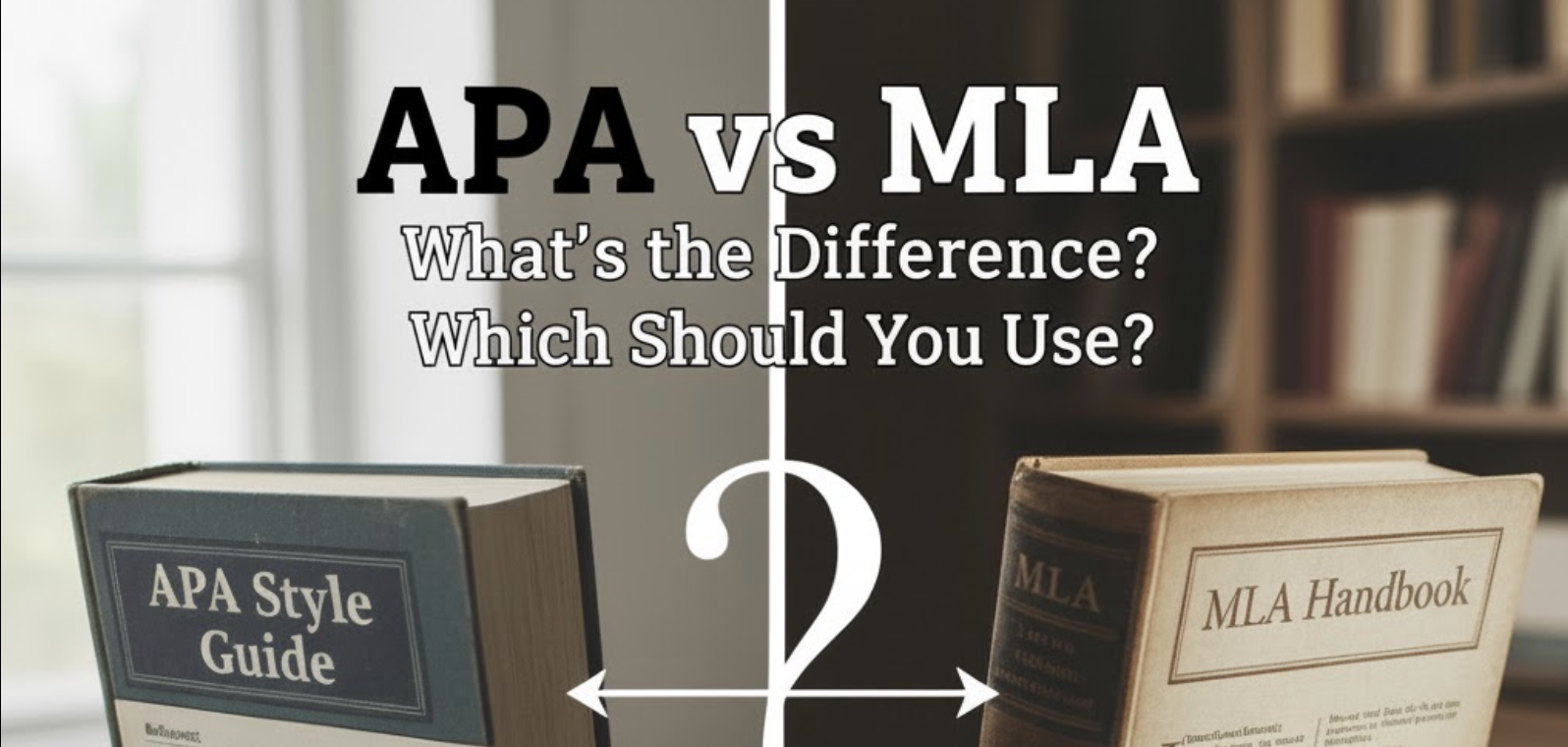
APA vs MLA: What’s the Difference and Which Should You Use?
APA vs MLA: What’s the Difference and Which Should You Use?
A concise, student‑friendly comparison of APA and MLA with side‑by‑side examples, formatting rules, and a quick decision flow.
Quick Overview
Both APA and MLA are widely used academic citation styles. APA (American Psychological Association) dominates in social sciences, education, business, and nursing. MLA (Modern Language Association) is standard in literature, languages, and many humanities disciplines.
APA vs MLA: Key Differences
| Feature | APA (7th ed.) | MLA (9th ed.) |
|---|---|---|
| Primary fields | Psychology, Sociology, Education, Nursing, Business | Literature, Linguistics, Philosophy, Cultural Studies |
| In‑text citations | Author–date: (Smith, 2022) or Smith (2022) |
Author–page: (Smith 23) or Smith argues ... (23) |
| Reference list title | References | Works Cited |
| Author names | Last name, initials: Smith, J. A. | Full names if available: Smith, John A. |
| Publication year | Always included (and central to the citation) | Usually not required in in‑text citations |
| Title capitalization | Sentence case for article/book titles; italics for books | Title case for most titles; italics for books/containers |
| Source details | DOI preferred; URL when DOI unavailable; publisher location not needed | URL optional; DOI if available; city not needed for most sources |
| Running head | Student papers: page number only; Professional papers: optional running head | No running head; header includes last name + page number |
| Abstract | Often required (especially in professional/empirical papers) | Rare in MLA papers |
In‑Text Citation Examples
APA (Author–Date)
Paraphrase: (Smith, 2022) · Narrative: Smith (2022) found ... · Direct quote with page: (Smith, 2022, p. 45)
// Paraphrase
According to Smith (2022), social support predicts persistence.
// Parenthetical
Empirical evidence supports this trend (Smith, 2022).
// Direct quote
“This effect was strongest for first‑generation students” (Smith, 2022, p. 45).MLA (Author–Page)
Paraphrase: (Smith 45) · Narrative: Smith argues ... (45) · Multiple authors: (Smith and Lee 45)
// Paraphrase
Some scholars frame the novel as a travel narrative (Smith 45).
// Narrative
Smith contends the text resists categorization (45).
// Two authors
The motif recurs across editions (Smith and Lee 45).Reference Page (APA) vs Works Cited (MLA)
APA References (7th ed.)
Book
Lastname, I. I. (Year). Title in sentence case. Publisher.
Smith, J. A. (2022). Learning that lasts. Open Press.
Journal article
Lastname, I. I., & Lastname, I. I. (Year). Title of article in sentence case. Journal Title in Title Case, Volume(Issue), pages. https://doi.org/xxxxx
Lee, K., & Smith, J. A. (2021). Revisiting replication. Research Methods, 10(2), 123–140. https://doi.org/10.0000/rm.2021.12345
Webpage
Organization or Lastname, I. I. (Year, Month Day). Title in sentence case. Site Name. URL
National Science Foundation. (2023, May 4). Funding opportunities. NSF. https://nsf.gov/funding
MLA Works Cited (9th ed.)
Book
Lastname, Firstname. Title in Title Case. Publisher, Year.
Smith, John A. Learning That Lasts. Open Press, 2022.
Journal article
Lastname, Firstname, and Firstname Lastname. "Title in Title Case." Journal Title, vol. number, no. issue, Year, pp. pages. DOI/URL.
Lee, Kai, and John A. Smith. "Revisiting Replication." Research Methods, vol. 10, no. 2, 2021, pp. 123–140. https://doi.org/10.0000/rm.2021.12345.
Webpage
Author or Organization. "Title in Title Case." Website Name, Day Month Year, URL.
National Science Foundation. "Funding Opportunities." NSF, 4 May 2023, https://nsf.gov/funding.
Paper Formatting Basics
APA essentials
- 12‑pt Times New Roman (or equivalent), double‑spaced, 1‑inch margins
- Title page (student or professional format)
- Page numbers in top‑right; running head optional (professional)
- Section headings (Levels 1–5) for structure
- Abstract often required for empirical papers
MLA essentials
- 12‑pt Times New Roman (or equivalent), double‑spaced, 1‑inch margins
- Student name block (name, instructor, course, date) on first page
- Header with last name and page number, top‑right
- Titles centered (no bold/underline/quotes unless part of title)
- No abstract; use paragraphing and signal phrases for flow
How to Choose the Right Style
- Check the assignment or journal guidelines. This overrides everything.
- Match the discipline. Social sciences → APA. Humanities → MLA.
- Consider your sources. If you cite many recent studies where the year matters, APA’s author–date format can help readers quickly assess currency.
- Stay consistent. Don’t mix styles within the same paper.
Social sciences → APA Humanities → MLA When in doubt → Ask
60‑Second Decision Flow
- Guidelines specify a style? Use that.
- Field is psychology, sociology, education, business, nursing? APA.
- Field is literature, languages, cultural/film studies, philosophy? MLA.
- No guidance and cross‑disciplinary? Prefer APA for empirical research; prefer MLA for textual analysis.
FAQ
Can I switch styles mid‑paper?
No. Pick one style and use it consistently from the title page to the final references.
Is APA or MLA easier?
APA is often easier when discussing time‑sensitive research because the year is always visible. MLA can feel more natural for close readings of texts where page numbers matter most.
What edition should I use?
APA 7th edition and MLA 9th edition are the current standards used in most institutions. Always confirm with your instructor.
Do I need an abstract?
APA papers often include an abstract (especially research reports). MLA papers typically do not.